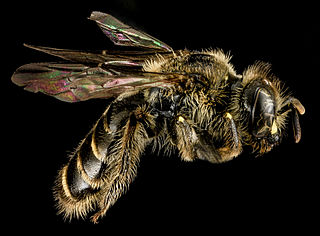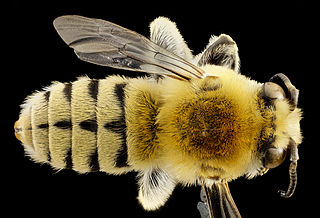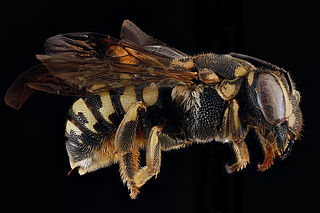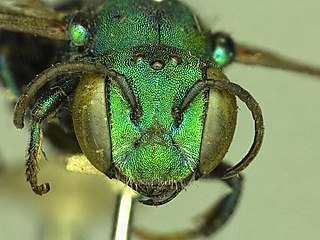
Megachilidae is a cosmopolitan family of mostly solitary bees. Characteristic traits of this family are the restriction of their pollen-carrying structure to the ventral surface of the abdomen, and their typically elongated labrum. Megachilid genera are most commonly known as mason bees and leafcutter bees, reflecting the materials from which they build their nest cells ; a few collect plant or animal hairs and fibers, and are called carder bees, while others use plant resins in nest construction and are correspondingly called resin bees. All species feed on nectar and pollen, but a few are kleptoparasites, feeding on pollen collected by other megachilid bees. Parasitic species do not possess scopae. The motion of Megachilidae in the reproductive structures of flowers is energetic and swimming-like; this agitation releases large amounts of pollen.

The cosmopolitan bee genus Ceratina, often referred to as small carpenter bees, is the sole lineage of the tribe Ceratinini, and is not closely related to the more familiar carpenter bees. The genus presently contains over 300 species in 23 subgenera. They make nests in dead wood, stems, or pith, and while many are solitary, a number are subsocial, with mothers caring for their larvae, and in a few cases where multiple females are found in a single nest, daughters or sisters may form very small, weakly eusocial colonies. One species is unique for having both social and asocial populations, Ceratina australensis, which exhibits all of the pre-adaptations for successful group living. This species is socially polymorphic with both solitary and social nests collected in sympatry. Social colonies in that species consist of two foundresses, one contributing both foraging and reproductive effort and the second which remains at the nest as a passive guard. Cooperative nesting provides no overt reproductive benefits over solitary nesting in this population, although brood survival tends to be greater in social colonies. Maternal longevity, subsociality and bivoltine nesting phenology in this species favour colony formation, while dispersal habits and offspring longevity may inhibit more frequent social nesting in this and other ceratinines.

Caupolicana is a genus of bees in the family Colletidae, native to the Americas; most species are crepuscular in habit, visiting flowers only at dawn and/or dusk. There are over 50 known species, in 4 subgenera.

Calliopsis is a genus of panurgine bees in the family Andrenidae. There are over 80 described species distributed throughout the western hemisphere.

Epeolus is a genus of cuckoo bees of the tribe Epeolini, the subfamily Nomadinae part of the honey bee family Apidae. They are often known as variegated cuckoo-bees.
Neopasites is a genus of cuckoo bees in the family Apidae. There are about 5 described species in Neopasites.

Anthidiini is a tribe of insects in the family Megachilidae. There are at least 40 genera and 840 described species in Anthidiini. There is strong evidence that the tribe is monophyletic.
Conanthalictus is a genus of sweat bees in the family Halictidae. There are about 13 described species in Conanthalictus.

Lithurgopsis is a genus of northern cactus woodborers in the family Megachilidae. There are at least nine described species in Lithurgopsis.

Habropoda is a genus of anthophorine bees in the family Apidae. There are at least 50 described species in Habropoda.
Sapyga louisi is a species of club-horned wasp in the family Sapygidae. Adults feed from flowers and larvae are kleptoparasites of leaf cutter bee larvae, including those of Heriades carinata.

Dianthidium simile is a species of leafcutter, mason, and resin bees in the family Megachilidae. It is found in North America.
Stelis interrupta is a species of leafcutter, mason, and resin bees in the family Megachilidae. It is found in North America.

Stelis is a genus of kleptoparasitic bees in the family Megachilidae. There are at least 100 described species in Stelis.

Osmia foxi is a species of mason bees in the family Megachilidae. It is found in New Mexico and southeastern Arizona in the United States and in Sonora, Mexico.

Osmiini is a tribe of leafcutter, mason, and resin bees in the family Megachilidae. There are about 19 genera and at least 1,000 described species in Osmiini.

Trachusa is a genus of leafcutter, mason, and resin bees in the family Megachilidae. There are at least 50 described species in Trachusa.

Ashmeadiella is a genus of bees in the family Megachilidae. There are more than 60 described species in Ashmeadiella.

Brachymelecta is a genus of digger-cuckoo bees in the family Apidae, formerly known by the name Xeromelecta.

Anthidiellum is a genus of rotund resin bees in the family Megachilidae. There are more than 60 described species in Anthidiellum.
















